
By Debi Blaney - NOAA Office of Ocean Exploration and Research
July 11, 2016
The 2016 Deepwater Exploration of the Marianas expedition contained a number of exciting discoveries. Our science team will spend the next several months to years pouring over them; they will analyze samples, describe new species, publish the findings, and provide the most up-to-date information to resource managers.
As this was my first experience with the deep sea, I learned many fascinating things about the ocean, the ecosystems we visited, and about the Marianas as a whole from the participating science team. Below are some of my favorite lessons learned:
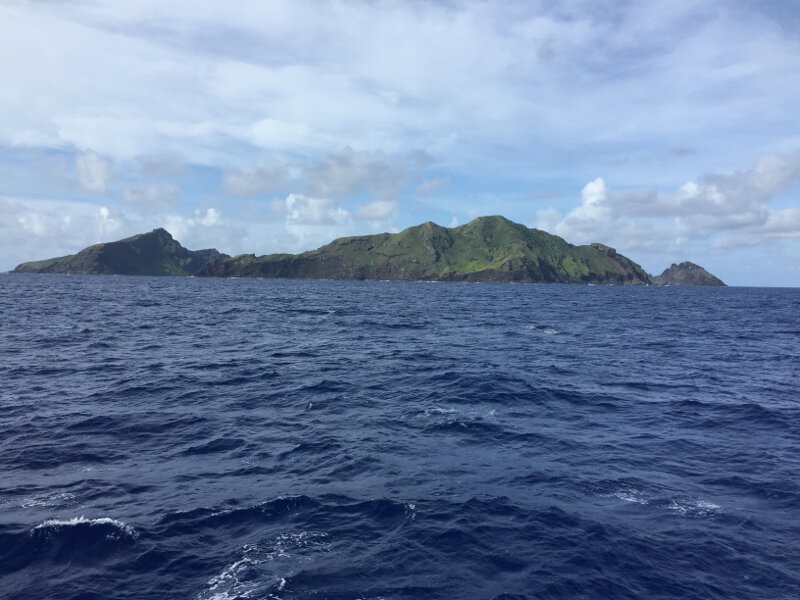
Maug, one of the volcanos within the Islands Unit of the Marianas Trench Marine National Monument, as seen from NOAA Ship Okeanos Explorer during Dive 3 of Leg 3. Image courtesy of NOAA Office of Ocean Exploration and Research, 2016 Deepwater Exploration of the Marianas. Download larger version (jpg, 4.0 MB).
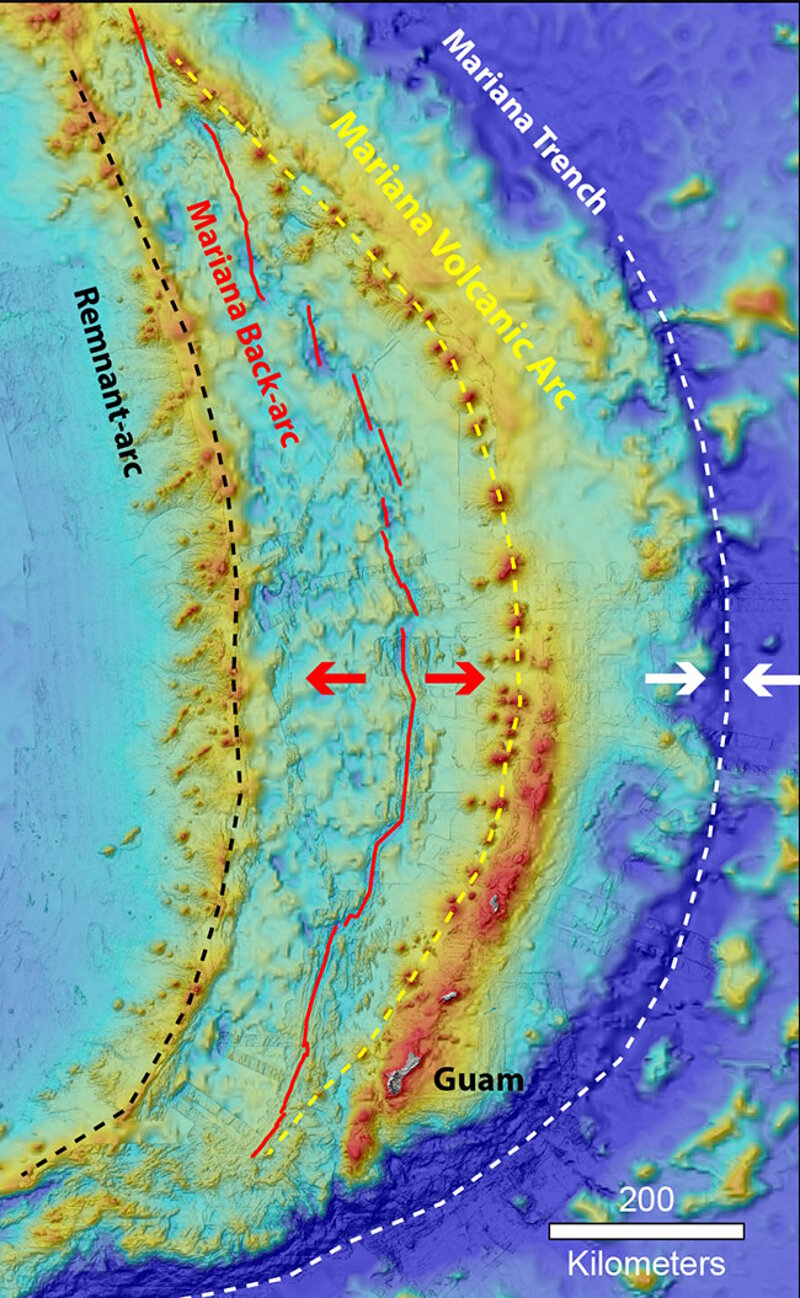
Map showing the locations of the Mariana Trench (white dashed line), Volcanic Arc (yellow dashed line), and back-arc spreading center (red line) and remnant arc (black dashed line). Image courtesy of Bill Chadwick. Download larger version (jpg, 521 KB).
One of the first lessons I learned during this expedition was about the general terminology of the region. Leg 3 Science Team Co-lead Patty Fryer explained that when speaking of the Mariana Islands, one refers to them collectively as the Marianas, but when speaking of the Mariana Trench the “s” is not added.
Many people know that the Mariana Trench houses the deepest spot in the ocean, but do you know why it is shaped like a banana when seen from above? Deb Glickson, one of the Leg 1 Science Team Leads, explained that the ends of the trench are pinned in place by a plateau to the north and a ridge to the south, so they cannot move. However, as the trench location slowly moves eastward while the Pacific Plate is subducted beneath the Philippine Sea Plate, the Mariana Trench gets more and more curved over time.
Sea stars are preyed on by a variety of animals including fish, crabs, and shrimp, but did you know that some species of sea stars can regrow lost limbs and some can even regrow their entire body from just one arm?
According to Leg 1 Science Team Co-lead Diva Amon, deep-sea sea stars like brisingids extend their arms up into the water column to catch food passing by, so anytime there is a damaged arm, the brisingid needs to regenerate fast in order to survive.
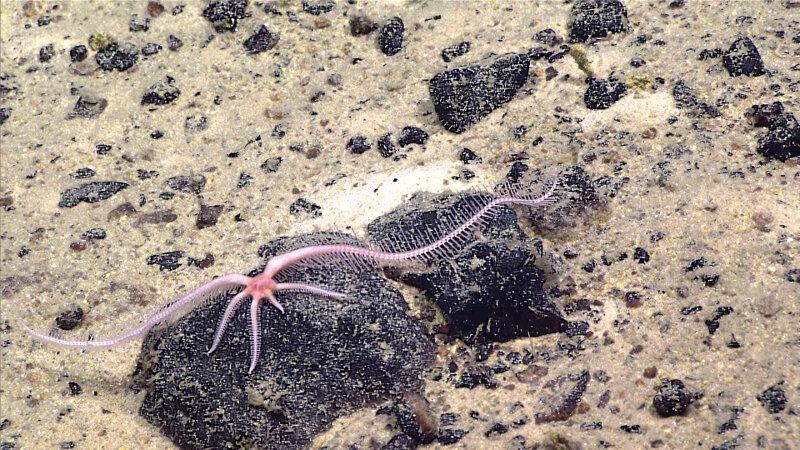
This brisingid sea star, seen while exploring Fryer Guyot, is in the process of regenerating four of its eleven arms. Image courtesy of NOAA Office of Ocean Exploration and Research, 2016 Deepwater Exploration of the Marianas. Download larger version (jpg, 1.9 MB).
During the expedition, scientists from around the world participate via telepresence to help guide the remotely operated vehicle (ROV), narrate the dive, and lend their expertise to ongoing operations. Bruce Mundy, a NOAA Fisheries Biologist and one of the expedition’s shore-based scientists, guided the team through fish identifications.
Throughout Leg 3, Bruce noticed that observations of eels, and eel-like fish, were fairly common. These fish did not seem to be scared off by the ROV; in fact, they appeared to be attracted to it. Apparently, this is not uncommon or unexpected for scavengers like these fish, as they could be attracted by the light, sound, vibration, electrical field – or maybe all of these.
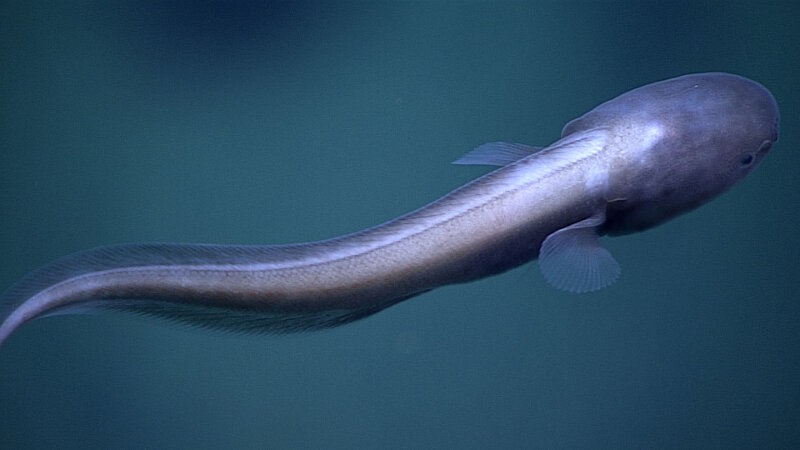
This fish was seen during a dive at Hadal Wall. Image courtesy of NOAA Office of Ocean Exploration and Research, 2016 Deepwater Exploration of the Marianas. Download larger version (jpg, 576 KB).
As the dives went on I noticed different forms of plural for the word “fish” being used, and asked Jeff Drazen, Professor at the University of Hawai‘i at Mānoa, which was the correct one. He explained that the plural of fish is “fish” when referring to several individuals of the same species, but it is “fishes” when referring to several individuals of different species.
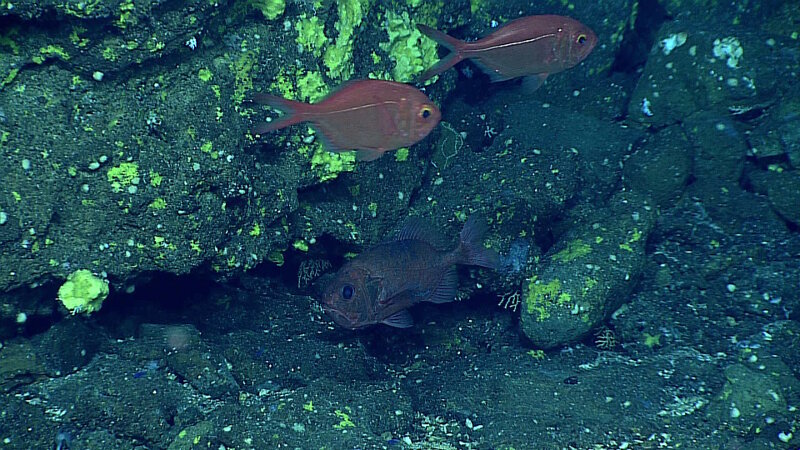
Fishes seen on a dive at Supply Reef. Image courtesy of NOAA Office of Ocean Exploration and Research, 2016 Deepwater Exploration of the Marianas. Download larger version (jpg, 1.3 MB).
Speaking of plurals, I also noticed different forms of plural used for the word “octopus.” I asked Liz Shea, the Delaware Museum of Natural History Curator of Mollusks, about that in an email, and she explained:
Octopuses is the most commonly used plural of octopus. “Octopi” is the Latinized plural ending that is often also listed in the dictionary as a plural. But “octopus” is a Greek word, so technically the plural would be “octopodes.” To get around all the confusion, we call all eight-armed cephalopods “octopods.” It's short, simple, clear, and useful in both casual and formal communication.
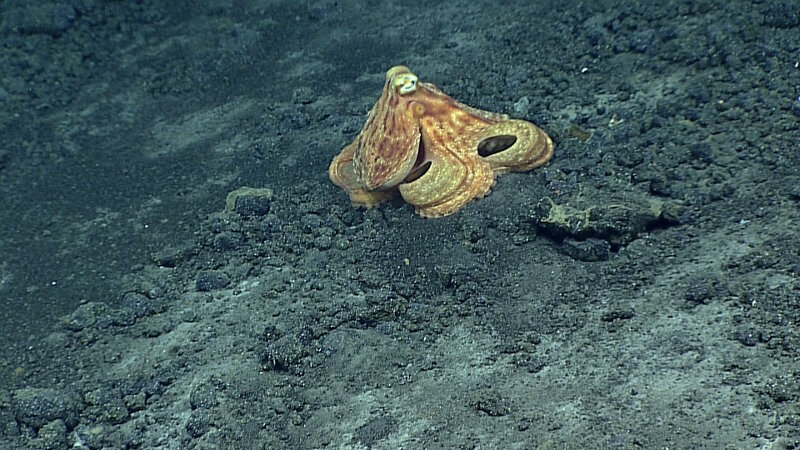
This octopus was seen on Dive 5 at Ahyi Seamount. Image courtesy of NOAA Office of Ocean Exploration and Research, 2016 Deepwater Exploration of the Marianas. Download larger version (jpg, 1.0 MB).
Another member of the shore-based science team, Scott France, helped to dispel a common misconception—that no matter how similar they may look to plants, the organisms observed during our dives are in fact animals. As light does not penetrate into the deep sea, marine photosynthetic organisms like algae or phytoplankton that require sunlight to live and grow cannot exist at depth. The depth you will stop seeing photosynthetic organisms depends on how clear the water is: in clear tropical water, they might survive to a depth of 150-200 meters, but in water with more suspended particles, the transition will be much shallower.
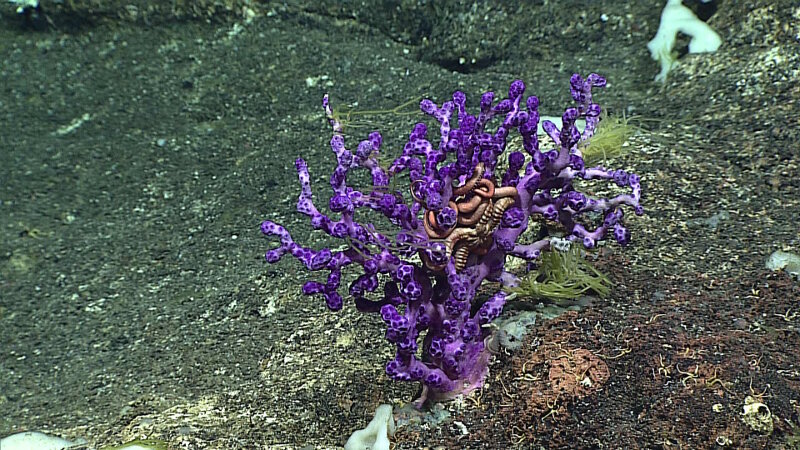
This coral and brittle star were seen on Dive 1 at Farallon de Medinilla (FDM).The green filamentous material hanging off of the coral is hypothesized to be algae that has drifted down from the sea surface. Image courtesy of NOAA Office of Ocean Exploration and Research, 2016 Deepwater Exploration of the Marianas. Download larger version (jpg, 1.2 MB).
One question that I found particularly interesting as I watched the dives was why do we find color in deep water where there is no light and color seemingly has no function? Shore-based scientist Chris Kelley provided an answer: a lot of organisms living in the deep have color, but it is likely not meant to be a visual signal such as camouflage or social cues. The molecules that the organisms need in their bodies for other functions reflect light when we shine it on them. Chris also pointed out that under their normal environmental conditions, there wouldn’t be any light to see the color, so the organisms would appear much differently.
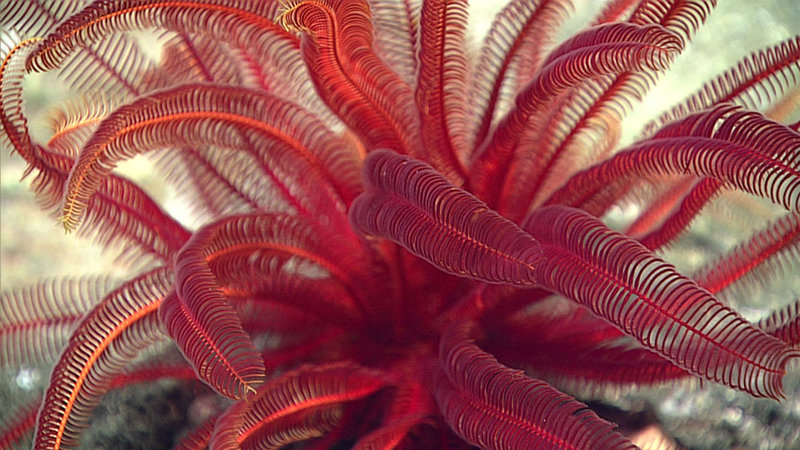
This beautiful crinoid, unusual for its many arms, was observed during Dive 3 as ROV Deep Discoverer (D2) explored a ridge feature along the outer slopes of Maug. In the deep sea, absent of D2’s artificial lights, this organism would appear black or disappear completely as red is one of the first colors to disappear from the visual spectrum in the ocean. Image courtesy of NOAA Office of Ocean Exploration and Research, 2016 Deepwater Exploration of the Marianas. Download larger version (jpg, 953 KB).
After the expedition I asked the participating science leads for some of their favorite moments from the dives, and Patty Fryer, marine geologist and Leg 3 Science Team Co-lead said: “Camouflage helps animals protect themselves from predators. So to this geologist, it was fun to see a holothurian (sea cucumber) using rocks for camouflage as a way to deter predation!”
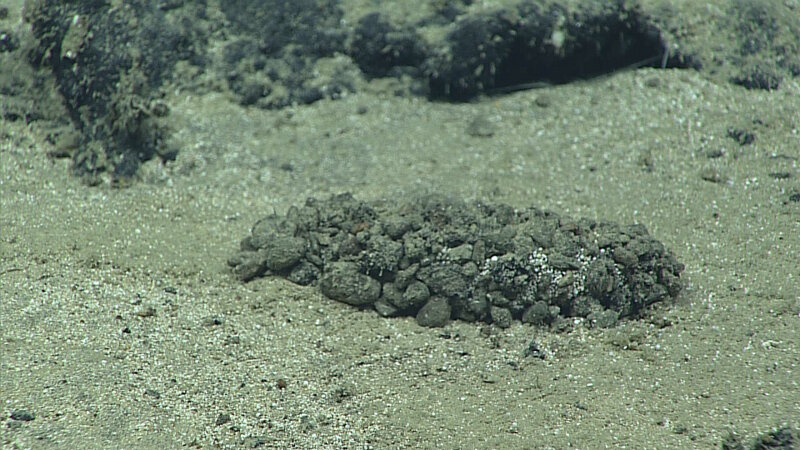
This holothurian was seen on Dive 12 at an unnamed forearc seamount. Image courtesy of NOAA Office of Ocean Exploration and Research, 2016 Deepwater Exploration of the Marianas. Download larger version (jpg, 984 KB).
One of Diva Amon’s favorite moments included the deep-sea snail, Alviniconcha hessleri. It only lives at hydrothermal vents and is probably one of the strangest deep-sea animals. Not only does it have blue blood due to the respiratory pigment hemocyanin and gets its food symbiotically from bacteria that live in its gills, but it also has hair-like projections on its shell, the purpose of which is unknown.
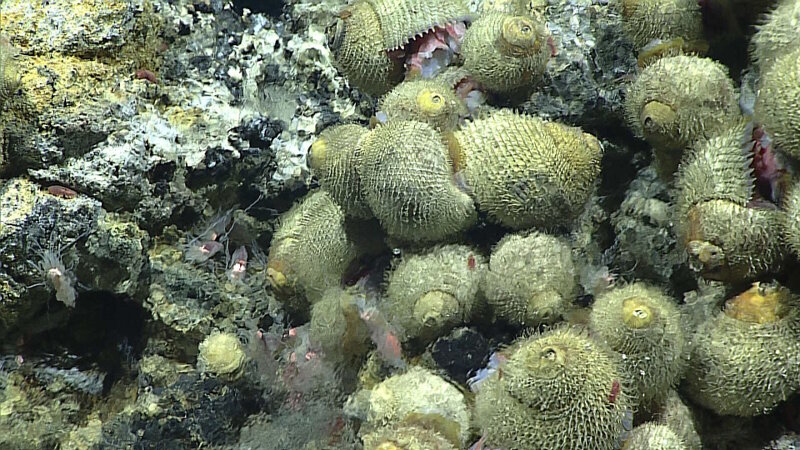
These snails were seen on Dive 7 at Chamorro Seamount. Parts of the picture look blurry due to hot water coming out of the hydrothermal vent. Image courtesy of NOAA Office of Ocean Exploration and Research, 2016 Deepwater Exploration of the Marianas. Download larger version (jpg, 1.1 MB).
Shirley Pomponi, Leg 3 Science Team Co-Lead and sponge expert, was fascinated by this unusual sponge. Most sponges feed by filtering small particles, like bacteria, from the water. But in the deep sea, where food is scarce, some sponges have become carnivores. Microscopic siliceous spicules form a Velcro-like surface that traps small crustaceans and polychaetes. The sponge then uses specialized cells to engulf and digest its prey.
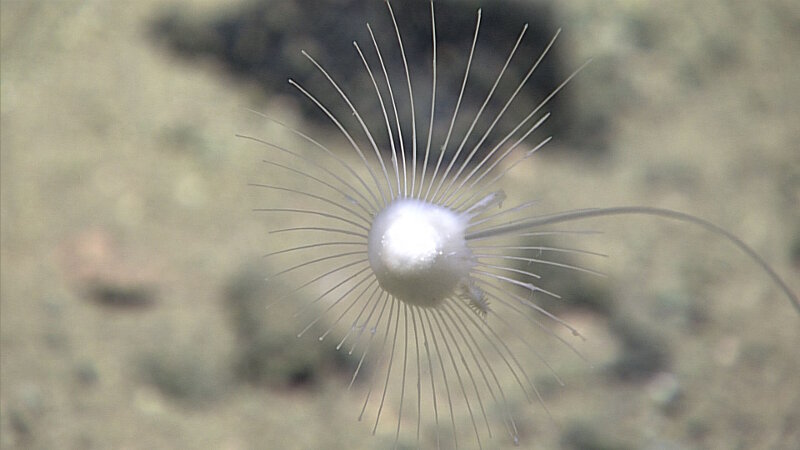
This sponge was seen at Hadal Wall. The swelling may indicate that the sponge has engulfed its prey, possibly a polychaete, and may be eating the worm. Image courtesy of NOAA Office of Ocean Exploration and Research, 2016 Deepwater Exploration of the Marianas. Download larger version (jpg, 585 KB).
Last but not least, I used to think of the deep sea as barren and devoid of life, but the abundance, diversity, and sheer beauty of life at depth that we observed was truly stunning. For example, this beautiful cnidarian—which resembles a sea anemone, but is actually a Relicanthus—is not only striking but also exhibits fascinating behaviors. It feeds itself by extending its long tentacles for up to two meters into the current to catch food floating by and then retracts the tentacles to move the food to its mouth.
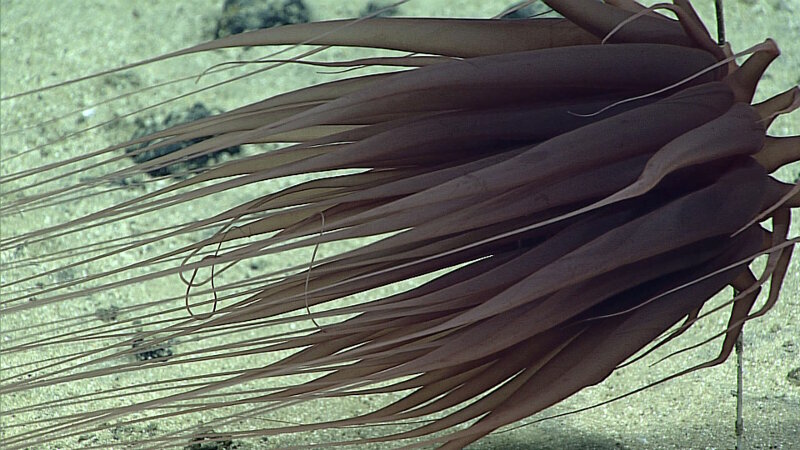
Relicanthus sp., a cnidarian resembling a sea anemone, seen on Dive 12 at an unnamed forearc seamount. Image courtesy of NOAA Office of Ocean Exploration and Research, 2016 Deepwater Exploration of the Marianas. Download larger version (jpg, 900 KB).
This was truly a fascinating expedition! Every day was filled with new discoveries and glimpses of a world that is dark and cold, yet filled with life. Okeanos Explorer’s next adventure takes us to the Wake Atoll area of the Pacific Remote Islands Marine National Monument, now known as Pacific Islands Heritage Marine National Monument. Join us live for more marvels of the deep sea as we keep exploring the unknown!